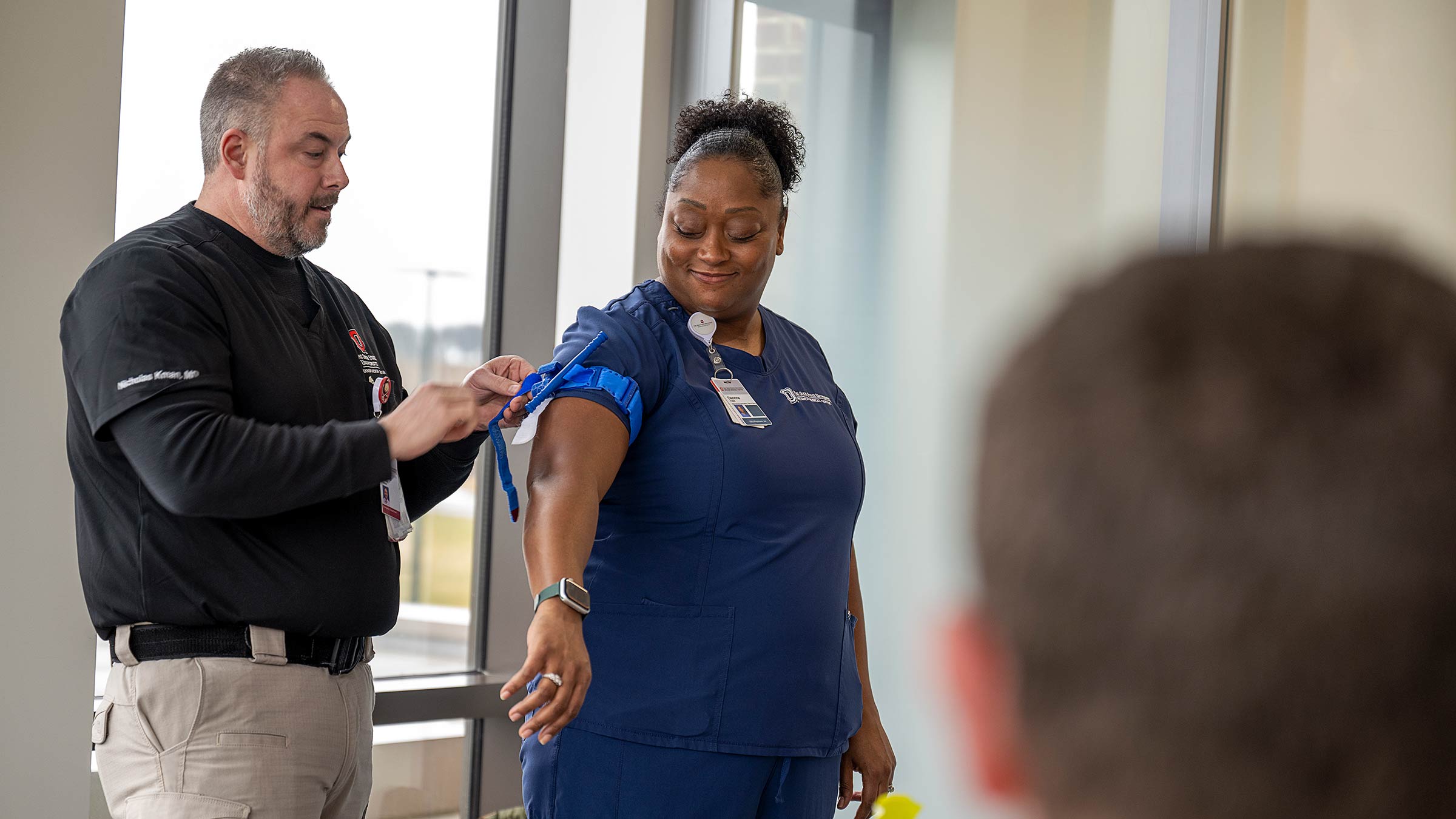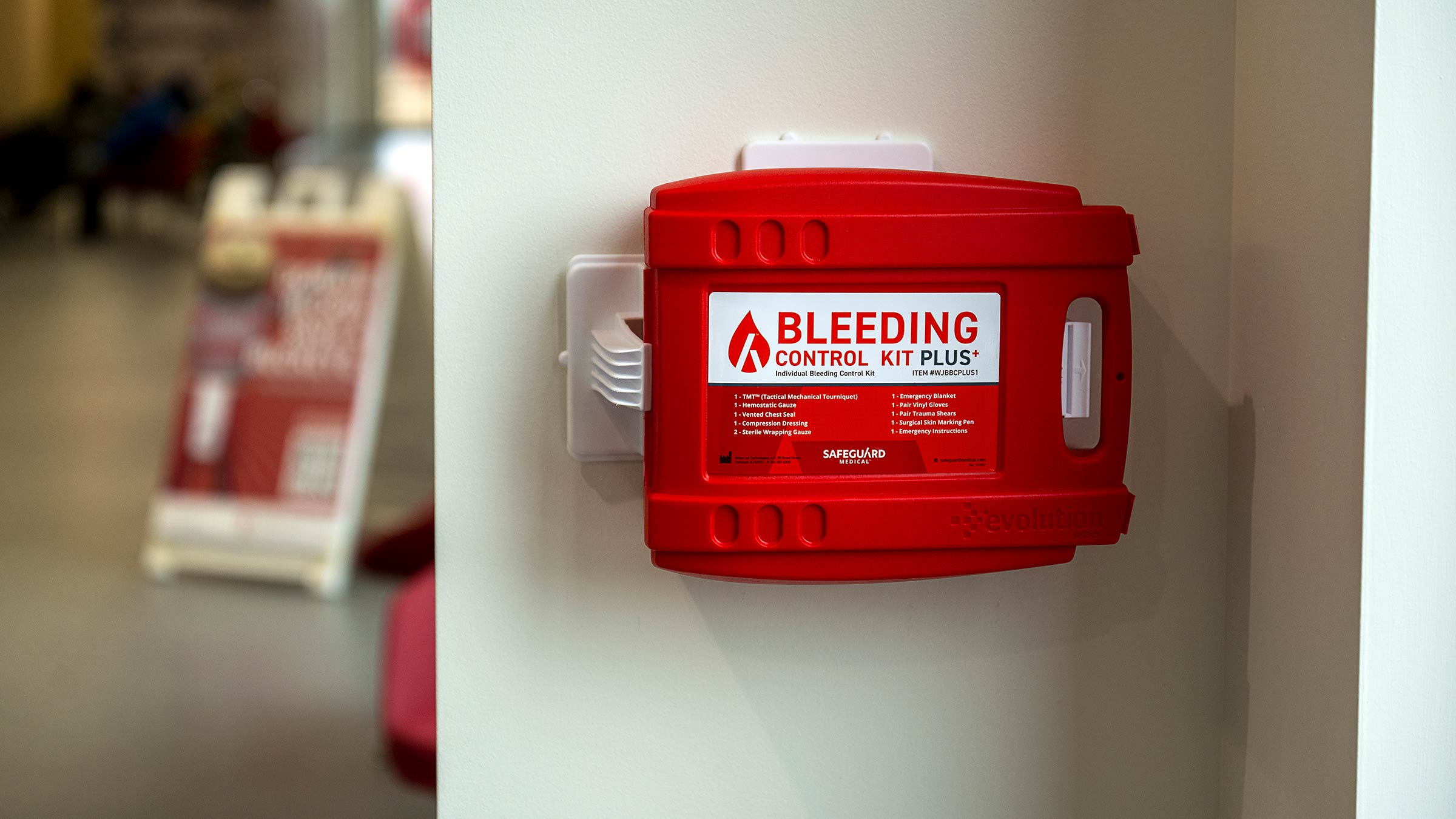
An active shooter. A car wreck. An accident on the soccer field. A slip-and-fall at the grocery store.
Any number of situations can lead to injuries.
And uncontrolled bleeding is the #1 cause of preventable deaths after they happen. In the most serious situations, a person can die in as little as 3 minutes.
There are a number of ways you can respond to save a life in an emergency, but only if you have the right tools.
STOP THE BLEED, a course developed by the American College of Surgeons, was created to put those tools in the hands of the public.
Here are the basics, including how to use a tourniquet:
Ensure your own safety
If you’re in an unsafe situation, get yourself to safety. If possible, take the injured person with you.
When treating a bleeding person, put on gloves if there’s time. If not, skin that’s intact (with no cuts) is a good barrier against infection. Try not to get blood in your eyes.
The ABCs of bleeding control
A — Alert 911. Even if you stop the bleeding, the victim will most likely need the help of a surgeon or other medical professional. So, call for help as soon as possible.
B — Bleeding. Find the source of bleeding. Look for continuous bleeding, a large volume of blood or pooling blood. Keep in mind that there may be multiple sites of bleeding. Also, clothing could be hiding the source of the bleeding, so feel the clothing for blood.
C — Compress. Compress to stop the bleeding by applying pressure, packing the wound or using a tourniquet.
Apply pressure to stop bleeding
For wounds that aren’t too deep, apply direct pressure to the wound, focusing on the location of the bleeding. Use just enough gauze or cloth to cover the wound. If the bleeding stops, hold constant pressure until help arrives.
Don’t lessen or remove pressure to check the wound. If you keep looking, bleeding won’t stop.
Packing the wound to stop bleeding
When blood is pooling inside a deeper wound, applying pressure on top of the wound won’t work to stop the bleeding. You’ll have to pack gauze or cloth inside the wound. You want to get the pressure up against the source of the bleeding.
Again, once you have the wound packed and bleeding under control, hold constant pressure on the wound, and don’t let up until help arrives.
Be careful not to drop gauze into any pooling blood, or it won’t be useful.
Using a tourniquet to stop bleeding
Tourniquets can be used on anyone except infants or very small children. Applying pressure will most often work on small children.
Generally, place tourniquets on limbs, about 2 to 3 inches above wounds, avoiding elbow or knee joints. They can pinch skin, so place over clothing if possible.
Tighten the tourniquet until the bleeding stops, then don’t remove it until help arrives, unless there’s good reason. A second tourniquet may be required to stop the bleeding.
Tourniquets hurt. The goal is to press vessels against the bone and the pulse will slow or even stop. Will this cause loss of a limb? It depends on the situation, but it’s best to keep the patient alive and worry about the limb later.
If you’re dealing with a snakebite, at least in the United States, skip the tourniquet. The toxin in the pit vipers found here goes through the body right away, and tourniquets can cause more damage than good. Your best bet is to get a good description of the snake to help the health care team find the right treatment.
Steps for applying a tourniquet
- Place band around limb and loop end through buckle
- Pull as tight as possible
- Twist windlass (small crank) as tight as possible, until bleeding stops
- Lock windlass into plastic clip and wrap band around
- Cover with Velcro strap and record time
Purchased vs. improvised tourniquets
It’s best to purchase a high-quality tourniquet. Some reliable tourniquets are the Combat Application Tourniquet (C-A-T) and SOF tourniquet. Some discount tourniquets have reportedly failed when getting wet.
Another reliable but more affordable type of tourniquet, called the SWAT-T, is made to stretch and pull tightly around the limb before being tucked back into itself.

Relying on an improvised tourniquet can be risky. Belts or backpack straps, for example, aren’t engineered to serve as tourniquets, and you may not be able to find something to serve as a windlass. Will you be able to get it tight enough or hold that compression?
When you have a tourniquet, you know it will work, and it takes guesswork out of what will most likely be a chaotic situation.
Carrying a tourniquet
Tourniquets can be kept in a gym bag, purse, first aid kit or the trunk of your car. Or you can purchase tourniquet packs that also include gauze, small shears, gloves and a marker. If you’re not comfortable using one yet, there’s a good chance someone nearby will know how to apply it.

Also, keep your eyes open for bleeding control kits near AED (automatic external defibrillator) and naloxone stations in public places, like schools and gyms. They might be in arm’s reach in places where you haven’t yet noticed.
Deonna Hale BSN, RN, assistant director of Ambulatory Risk and Safety for OSU Physicians Inc. also contributed to this article.

When an emergency strikes, turn to The Ohio State University Wexner Medical Center’s full-service, state-of-the-art emergency departments
Our facilities are equipped to handle any medical emergency.
Find a location near you





